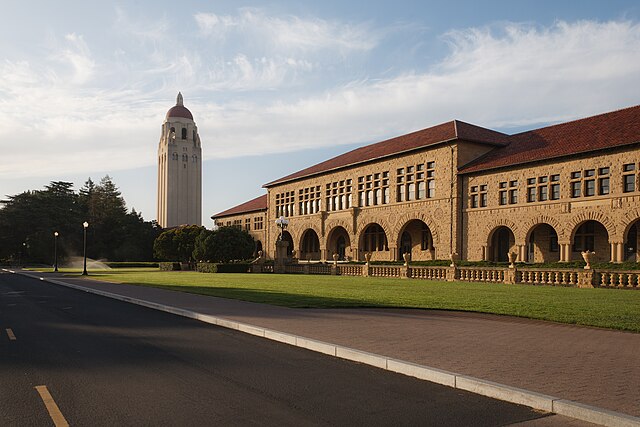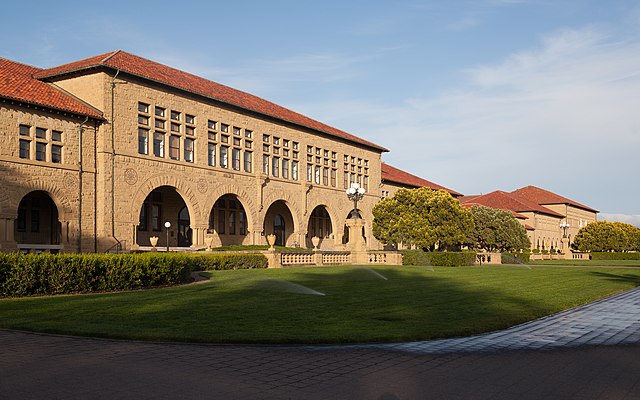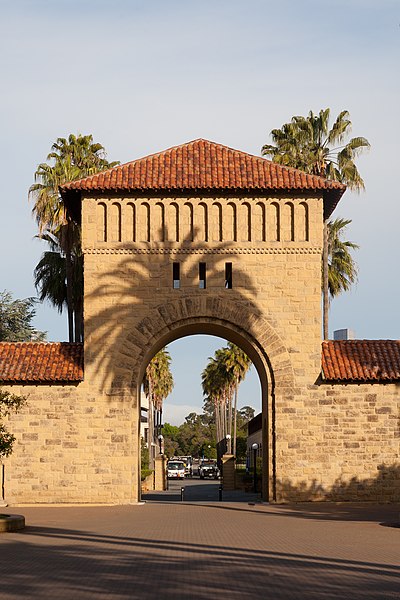
As Thammasat University students grow accustomed to online learning and distance education, some may wish to explore overseas opportunities after they have done their required coursework. Taking an extra class may be informative and help complement main areas of study, giving students new ideas and perspectives and help them to practice their English language usage.
One opportunity to consider may be free massive open online courses (MOOCs) at Stanford University, the United States of America.
Stanford University is a private research university in Stanford, California. The campus occupies 8,180 acres, among the largest in the United States, and enrolls over 17,000 students. Stanford is ranked among the best universities in the world.
The TU Library collection includes many books published by the Stanford University Press, a major academic publisher.
As of April 2021, 85 Nobel laureates, 29 Turing Award laureates, and eight Fields Medalists have been affiliated with Stanford as students, alumni, faculty, or staff. In addition, Stanford is particularly noted for its entrepreneurship and is one of the most successful universities in attracting funding for start-ups. Stanford alumni have founded numerous companies, which combined produce more than $2.7 trillion in annual revenue and have created 5.4 million jobs. Stanford is the alma mater of 74 living billionaires. It is also one of the leading producers of Fulbright Scholars, Marshall Scholars, and Rhodes Scholars.
Among free online courses of potential interest for TU students is Child Nutrition and Cooking. Its webpage description follows:
Stanford School of Medicine
Eating patterns that begin in childhood affect health and well-being across the lifespan. In the USA, we are in the midst of a childhood obesity epidemic that threatens to leave our children with a shorter life expectancy than their parents. As processed foods become more readily available around the world, other developed nations are beginning to follow suit. This course examines contemporary child nutrition in America from the individual decisions made by each family to the widespread food marketing targeting our children. The health risks associated with obesity in childhood are also discussed. Students will learn what constitutes a healthy diet for children and adults and how to prepare simple, delicious foods aimed at inspiring a lifelong celebration of easy home-cooked meals. This course will help prepare students to be the leading health providers, teachers and parents of the present and future.
Course Syllabus
Week one: Introduction to the problem – the childhood obesity epidemic facing the USA in particular and many developed nations who are following suit. Why should we care and what can be done? What are the current recommendations, how have they changed and how well are we doing in meeting our children’s dietary needs? Cooking also starts this week with how to make a simple breakfast and a stir-fry. We also explore the six basic ingredients every cook should have on hand!
Week two: What constitutes a balanced meal? What are carbohydrates, fats and proteins and how do we choose the healthiest of these? What is a glycemic index? Learn tricks for controlling portion sizes while maintaining satisfaction; cooking continues with more healthy breakfast alternatives, an easy dinner all in one dish, and a simple, (gluten-free) cake for special occasions.
Week three: How to pack a quick, healthy lunch for a child and why this is so important; how to shop for fruits and vegetables and navigate the supermarket for better health; what are the benefits of the family meal? How can we “make over” our children’s favorite foods, and help them enjoy healthier treats?
Week four: How do plant a kitchen garden? Gardening as a way of getting children excited about fresh foods; learn what’s meant by the terms “organic” and “locally grown”; learn more creative ideas for serving vegetables, how to involve children in the kitchen and basic techniques for making soups and cooking fish.
Week five: Summing it all up. What have we learned about encouraging the right food choices despite environmental challenges like advertising and readily available processed foods? How can we make choices that benefit our health and the health of our planet? Cooking this week: the simple stew, a basic homemade salad dressing plus a Sunday morning treat that will make the whole family smile.
Recommended Background
If you have access to basic cooking equipment, a source of food ingredients and a healthy dose of curiosity, we welcome you to join this course.
Suggested Readings
Weekly optional readings, which can be accessed through the internet, will be posted for discussion amongst class members.
Course Format
This course can be enjoyed by a wide variety of students who are interested in promoting health and enjoyment throughout their lives and the lives of the children they care for. Short 3-9 minute videos with integrated, introductory-level quizzes are paired with a collection of “blackboard style” videos that help us better understand our food. Dynamic food-preparation assignments and opportunities to collaborate with classmates around the world will add spice and flavor to this one-of-a-kind course.
Instructor
Maya Adam, MD, Lecturer, Stanford School of Medicine
Dr. Adam is also teaching another MOOC of potential usefulness, Health Across the Gender Spectrum:
Stanford School of Medicine
This course offers an intimate, story-based introduction to the real-life experiences of six transgender children and their families. Through illustrated stories and short teaching videos, learners will gain a better understanding of gender identity and the gender spectrum. Stanford physicians, K-12 educators, and transgender faculty members offer practical tips for parents, teachers, healthcare providers and anyone who wants to help create a more gender-expansive environment – one in which all people can live authentically. As a global community of unique individuals, we can begin to build a world that is ready to nurture and love each and every child. Due to the sensitive nature of the story-based course content, we have chosen not to offer course certificates for this course. Simply put, we feel that the thoughts, ideas and sentiments of these remarkable children and their families… are priceless. We are confident that, like us, you will end up learning more from them than you could ever imagine. Together, we can lay a stronger foundation for all children. Join us as we explore health, across the gender spectrum.
Who Should Enroll
This course is for anyone who cares about children and wants to make the world better for them. There are no prerequisites for this course.

Another possibility that may be useful for some TU students is COVID-19: Training for Healthcare Workers:
Stanford School of Medicine
Description
COVID-19 is rapidly spreading across the globe and all providers must be prepared to recognize, stabilize and treat patients with novel coronavirus infection. Following completion of this short course physicians, nurses, and other healthcare professionals will have a unified, evidenced-based approach to saving the lives of patients with COVID-19, including those who are critically ill.
Learning modules are broken into short videos presented in a richly illustrated and compelling manner. The course is self paced and providers can schedule their learning to fit with their schedules. Topics include symptoms and signs in patients with COVID-19, early stabilization of patients, preventing the need for intubation, and ventilator management. The best evidence and guidelines are summarized while accompanying handouts provide written learning points and links to online resources. Simple infographics are available for providers to utilize within their care facilities to educate and promote optimal care across their entire institution.
We are pleased to offer our COVID-19 Training for Healthcare Workers in multiple languages in order to deliver this critical content to more physicians, nurses, community health workers, and other health practitioners around the world.
To learn more about our other programs and find additional resources, please visit Stanford Emergency Medicine International, The Stanford Center for Health Education, and our Digital Medic Initiative.
What you will learn
- Key features of COVID-19 and common presenting symptoms.
- Prevention of COVID-19 transmission to healthcare providers and other individuals.
- How to assess and give immediate care to patients in acute respiratory distress to prevent worsening.
- How to provide advanced management and stabilization of patients in severe respiratory distress, including early ventilator management.
Notes
For individuals that need to access this course in low data bandwidth settings, please download our Digital Medic app available on iOS and Google Play, where learning modules can be viewed on mobile devices and downloaded for later viewing in offline mode.

Still another opportunity is Game Theory:
Stanford School of Engineering
Popularized by movies such as “A Beautiful Mind,” game theory is the mathematical modeling of strategic interaction among rational (and irrational) agents. Beyond what we call `games’ in common language, such as chess, poker, soccer, etc., it includes the modeling of conflict among nations, political campaigns, competition among firms, and trading behavior in markets such as the NYSE. How could you begin to model keyword auctions, and peer to peer file-sharing networks, without accounting for the incentives of the people using them? The course will provide the basics: representing games and strategies, the extensive form (which computer scientists call game trees), Bayesian games (modeling things like auctions), repeated and stochastic games, and more. We’ll include a variety of examples including classic games and a few applications.
You can find a full syllabus and description of the course here.
You can find an introductory video here.
Instructors
Matthew O. Jackson, Professor of Economics, Stanford University
Kevin Leyton-Brown, Professor of Computer Science, The University of British Columbia
Yoav Shoham, Professor of Computer Science, Stanford University

(All images courtesy of Wikimedia Commons)
